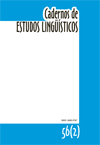Abstract
O trabalho busca explorar o discurso sobre o Dia da Consciência Negra no Brasil, através do Twitter. Há dois objetivos: (1) Explorar as contribuições de um design metodológico de Análise de Conteúdo com foco referencial e Análise de Redes para grandes conjuntos de dados, especialmente aqueles coletados em sites de rede social e; (2) Discutir como as redes de conceitos auxiliam a compreender, através da exclusão e da presença, o discurso sobre a data. Para tanto, foram coletados e analisados mais de 2 mil tweets. Os resultados apontam para um discurso de exclusão do negro enquanto ator, uma marginalização deste e redução de seu sentido àquele da descrição da data.References
BARDIN, Laurence. Análise de Conteúdo. Lisboa: Edições 70, 2007.
BARON, N. Foreword. In: Thurlow, C. e Mroczek, C. Digital Discourse: Language in the New Media. Oxford : Oxford University Press, 2011.
BENTO, M. A. S. e BEGHIN, N. Juventude Negra e Exclusão Radical. IPEA. Políticas sociais - acompanhamento e análise | 11 | ago. 2005. Disponível em: http://www.en.ipea.gov.br/agencia/images/stories/PDFs/politicas_sociais/ENSAIO4_Maria11.pdf . Acesso em 06 de Janeiro de 2014.
BERNSTEIN, M. BAKSHY, E; BURKE, M.; KARRER, B. Quantifying the Invisible Audience in Social Networks. Proceedings of CHI 2013, April 27–May 2, 2013, Paris, France.
RECUERO – Discutindo Análise de Conteúdo como Método: O #DiadaConsciênciaNegra no Twitter BOURDIEU, P. Language and Symbolic Power. Massachusetts: Harvard University Press, 1991.
BOYD, D. Social Network Sites as Networked Publics: Affordances, Dynamics, and Implications. In: Networked Self: Identity, Community, and Culture on Social Network Sites (ed. Zizi Papacharissi), pp. 39-58, 2010.
BOYD, D. M., e ELLISON, N. B. Social Network Sites: Definition, History, and Scholarship. Journal of Computer-Mediated Communication, 13(1), 210-230, 2007.
BOYD, D. GOLDER, S., LOTAN, G. “Tweet, Tweet, Retweet: Conversational Aspects of Retweeting on Twitter.” HICSS-43. IEEE: Kauai, HI, January 6, 2010. Disponíve em: http://www.danah.org/papers/TweetTweetRetweet.pdf Acesso em 06/01/2014.
CASTELLS, M. A Galáxia da Internet. Rio de Janeiro: Jorge Zahar, 2003.
DEGENNE, A. e FORSÉ, M. Introducing Social Networks. London: Sage, 1999.
FREITAS, M. Refletir sobre a história do Negro no Brasil: Uma resposta ao racismo. II Congresso de Educação – UEG/UnU Iporá - A formação de professores: uma proposta de pesquisa a partir da reflexão sobre a prática docente, 2012. Disponível em: http://www.cdn.ueg.br/arquivos/ipora/conteudoN/975/CE_2012_27.pdf. Acesso em 05/01/2014.
FOUCAULT, M. A Ordem do Discurso. Aula Inaugural no Collège de France. 02 de dezembro de 1970. São Paulo: Edições Loyola, 5a edição, 1999. _ FOUCAULT, M. A Arqueologia do Saber. Rio de Janeiro: Forense Universitária, 2009.
GIACOMONI, M. P, e VARGAS, A. Z. Foucault, a Arqueologia do Saber e a Formação Discursiva. Veredas, 2/2010, p. 119-129. Disponivel em: http://www.ufjf.br/revistaveredas/files/2010/04/ artigo-09.pdf. Acesso em 28/12/2013.
GOLZIO, D. Exclusão informativa: representação e representatividade dos negros e afrodescendentes nas capas da revista Veja. III SOPCOM, VI LUSOCOM e II IBÉRICO – Volume III. Em: Biblioteca Online de Ciências da Comunicação, 2004. Disponível em: http://www.bocc.ubi.pt/pag/golzio-derval-exclusao-informativa-representacao-e-representatividade-dos-negros-eafrodescendentes-nas-capas-da-revista-veja.pdf Acesso em 06/01/2014.
HALL, S. Foucault: Power, Knowledge and Discourse. In: Discourse Theory and Practice: A Reader Edited by Margaret Wetherell, Stephanie Taylor, Simeon J Yates. London: Sage, 2001. (pp. 324 - 344)
HERRING, S. Computer-Mediated Discourse. In: Handbook of Discourse Analysis, edited by Deborah Tannen, Deborah Schiffrin, and Heidi, Hamilton. Oxford: Blackwell. 2001. Disponível em: http://www.let.rug.nl/redeker/herring.pdf. Acesso em 02/01/2014.
HONEYCUTT C., & HERRING, S. C. Beyond microblogging: Conversation and collaboration via Twitter. Proceedings of the Forty-Second Hawai’i International Conference on System Sciences (HICSS-42). Los Alamitos, CA: IEEE Press, 2009. Disponível em: http://ella.slis.indiana.edu/~herring/honeycutt.herring.2009.pdf. Acesso em 02/01/2014.
KRIPPENDORF, K. Content Analysis, An Introduction to Its Methodology. 3a Ed. Thousand Oaks, CA: Sage Publications, 2012.
OSGOOD, C. The representational model and relevant research methods. In: POOL, I. de S. Trends in Content Analysis, Urban, Univ. of Illinois Press, 1959.
PAGE, R. The linguistics of self-branding and micro-celebrity in Twitter: The role of hashtags. Discourde & Communication: May 2012 vol. 6 no. 2, pp. 181-201.
RAMBE, P. Critical discourse analysis of collaborative engagement in Facebook postings. Australasian Journal of Educational Technology, 2012, 28(2), 295-314.
RECUERO, R. Redes Sociais na Internet. Porto Alegre: Sulina, 2009.
RECUERO, Raquel; ZAGO, Gabriela. RT, por favor: considerações sobre a difusão de informações no Twitter. Revista Fronteiras (Unisinos), 2010. Disponível em: http://www.fronteiras.unisinos. br/index.php?e=5&s=9&a=88. Acesso em 05/01/2014.
ROSEN, D., STEFANONE, M.; LACKAFF, D. Online and Offline Social Networks: Investigating Culturally-Specific Behavior and Satisfaction. Proceedings of the 43rd Hawaii International Conference on System Sciences , 2010.
SCOTT, J. Social Network Analysis. A handbook. 2a ed. London: Sage, 2004.
SOUZA, C.; AMARAL, M.; GUIMARAES, S. A multifuncionalidade do Twitter sob a perspectiva da Análise Crítica do Discurso: uma análise de tweets sobre a profissão-perigo professor. Linguagens e Diálogos, v. 2, n. 1, p. 1-30, 2011.
STEINFELD, C., ELLISON, N. & LAMPE, C. Social capital, self-esteem, and use of online social network sites: A longitudinal analysis. Journal of Applied Developmental Psychology, 29 (6), 2008, 434-445. Disponível em: https://www.msu.edu/~steinfie/Steinfield_Ellison_Lampe(2008).pdf. Acesso em agosto de 2013.
WASSERMAN, S. & FAUST, K. Social Network Analysis. Methods and Applications. Cambridge, Cambridge University Press: 1994.
WALTON, S. e JAFFE, A. Stuff White People Like’: Stance, Class, Race and Internet Commentary. In: Language in the New Media: Sociolinguistic Perspectives, edited by Crispin Thurlow and Kristine Mroczek. Oxfored University Press, 2011.
ZAPPAVIGNA, M. Ambient affiliation: A linguistic perspective on Twitter. New Media & Society August 2011 13: 788-806, Maio de 2011 doi:10.1177/1461444810385097
ZAGO, Gabriela. Dos Blogs aos Microblogs: Aspectos Históricos, Formatos e Características. VI Congresso Nacional de História da Mídia – maio de 2008 em Niterói, RJ. Disponível em http:// bocc.ubi.pt/pag/zago-gabriela-dos-blogs-aos-microblogs.pdf. Acesso em 02/01/2014.
The journal CADERNOS DE ESTUDOS LINGUÍSTICOS is granted all the copyright related to the published works. The originals will not be returned. By virtue of being part of this public access journal, the articles are free to use, with their own attributions, in educational and non-commercial applications

